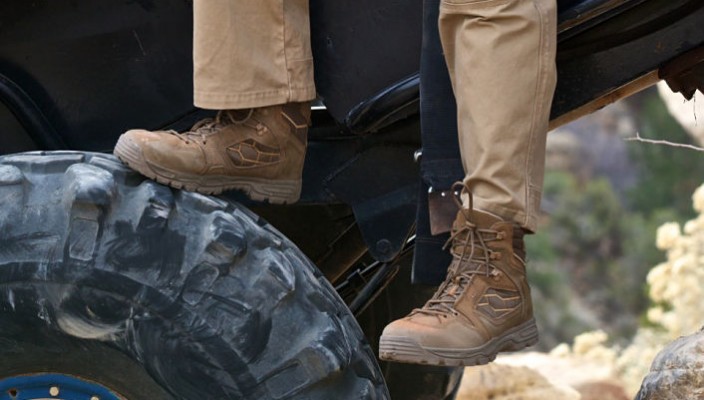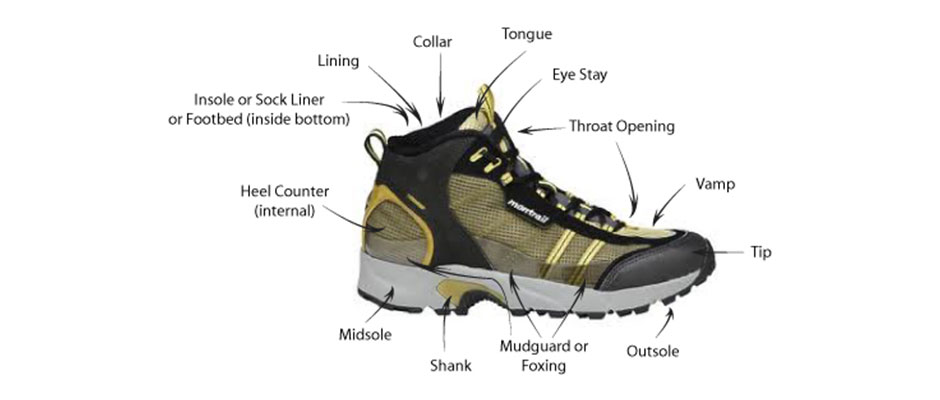
I have to get this off my chest right away, I’m a boot nerd. By nerd I mean that I like to stay in “the know” on footwear technology and actively search out the very best boot based on my needs. What can I say? I believe that every person needs a solid foundation covering their feet and that the shoes and boots you choose to walk out of your house with every morning, speak loudly about your character.
Now that the records straight, It’s a given that you came to this article to learn a thing or two about boots. Some of what I’m about to tell might be a little taboo. Why? Well because it doesn’t do a good job at upselling you on the flashiest pair of boots on the market but that’s not what I’m here to help you with. I, like you, want to get the most for my money and not spend another nickel for anything extra that I don’t need.
Without further ado…… The features/characteristics you’ll want in a hiking boot are as follows:

Photo courtesy of yourproofofconcept.com
Midsole: EVA or Poly
Going off of my solid foundation statement above, the midsole of your boot might just be the most crucial determining factor of whether or not you’ve just purchased a 2lb hunk of leather and rubber or a true “conquer any terrain” terranaut.
The frame of every and all boots, the midsole sits between the rubber outer sole of your boot and the thin removable insole on the inside-hence its name.
Now 99.9% of boots have either an EVA (Ethylene Vinyl Acetate) or Polyurethane midsole. So what’s right for you? Majority of the time the lower cost EVA offering will be more than adequate for your day hiking or weekend trip off the grid. BUT….. If you plan on getting your Forest Gump on and doing extended long distance treks, than the additional cost of a boot with a Poly midsole is my best advice because of its increased durability and overall firmness.
Style of Boot
For the most part when you’re talking about a boot, you have two styles or profiles to pick from (hiking shoes excluded).
6” Heel aka Mid
-When you’re looking for equal parts speed and support, the mid or roughly six inch heeled boot is your best bet. Because of its lower heel you’re able to get more flexibility out of the boot and also keep the weight down on the boot, both of which aid in speed. This should be your first choice if you’re going to be hiking with under 30 pounds on your back.
8” Heel and up
–There’s a reason the military issues this size to our soldiers, it hits the sweet spot of stability under load. Yes you’ll lost out on some agility and speed with a boot eight inches and up but what you get in return is the capability of being able to haul considerably more weight on your back safely and comfortably. Another additional benefit of this style is it provides extended protection for your shins over the mid boot.

Outsole:
-While only slightly less important than the midsole of the boot, you could relate the outsole to a car tire. Meaning…….. Well you wouldn’t want to put offroad tires on your Honda Accord, would you? The same concept applies here. Pick a boot that is going to have the correct density and tread pattern for what you’ll be using your boots for mainly.
The density or hardness of the rubber outsole will play a considerable role in your traction and comfort or lack thereof. The harder the sole the more durable and comfortable the boot will be for extended hikes especially with a lot of weight on your back BUT…. this also means traction on slick surfaces like wet rocks will be less than ideal. Whereas yes a softer outsole can grip better on smoother surfaces, it will wear out much faster and not give you the proper cushioning if you’re hauling weight.
Plain and simple, pick a boot with an outsole that fits the environment you’re going to be hiking in and not because it looks cool.
Climashield/GORE-tex/ Waterproofing
DO NOT buy a boot with these features if you live in a warmer climate or will be hiking primarily in above 50 degree weather. However well the waterproofing of the boot is embellished on their site, trust me nothing is waterproof when it comes to boots. The coatings and materials used to repel or resist water will also keep your feet hotter than a June bride. “But, But” Yes there are many claims about how well this technology works at venting, it doesn’t. On numerous occasion I’ve wasted addition cash on a boot with GORE-Tex only to step in a stream and spend the rest of my trip outdoors walking around with a hot wet foot. If you’re going to be hiking in a sub 50 degree climate most of the time, then sure go for the waterproofing because it will keep your feet warmer, if not then save the money you would’ve spent on one of these waterproofing feautures on some nice wool socks.

Nubuck or Full Grain or Synthetic?
Undoubtedly a full grain leather boot will last a bit longer however it will be heavier than a similarly constructed synthetic boot. If you want added protection for your feet and a boot that’ll still be one waxing shy of looking brand new in two years? Then go with the leather. If you’re a fiend for speed and quick drying, than you may want to take a long hard look at a boot with a synthetic upper.
Sizing Tip:
-Make sure you leave enough wiggle room both side to side and at least 3/8 in front of your toes when picking out the correct size or blisters will soon be the bane of your existence.
You’re probably not going to find this info on a single boot manufacturer site, mostly because it’s the truth. Hell, I have no reason to lie to you about what you need to look for in a boot. The goal is to help you find the right boot for your specific hiking needs. The last thing you want is your gear to be the reason you have a bad time in the outdoors.
- Thermal Imaging for Home Defense? - February 3, 2016
- Top Gear from Vista Outdoors at SHOT Show 2016 - February 1, 2016
- The OTHER Hard Case Company - January 14, 2016
Related Posts
3 Responses to The Definitive Guide to All Things Hiking Boots
Leave a Reply
You must be logged in to post a comment.
« Serving Veterans One Penny at a Time with Gear Up for a Cause and the Fisher House Foundation And Now, A Look At Our Gear Up for a Cause Sponsors »



I sell hiking boots, and living near the smokies I have a lot of experienced hikers as customers. The only thing I’d like to challenge here is the waterproofing. Waterproofing, whether gore tex brand or a similar quality style, absolutely works, and can be great for puddles, shallower streams, and rain. It is hotter, so don’t get it to hike in a hot and/or dry area, but if you want to stay dry it’s a good option.
Hi Jeremy,
Thanks for the article.
There is a crossover happening with hiking boots and lighweight workboots (with toe protection and pierce resistant midsole). Both are useful for me for tree work, as is a stiffened shank and absence of any block heel.
You didnt mention anything about the shank, particularly interested in your take on shank/midsole stiffeners – either steel or synthetic; and on pierce resistant midsole.
Any suggestions??
Thanks,
Gus
Awesome scope already have one similar but would definitely purchase another for my savage hunter110 in .243 cal.